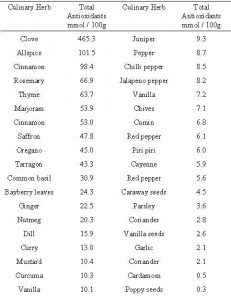Plant foods are a rich source of antioxidants, which are thought to confer protective effects against various degenerative diseases. Antioxidants help protect from disease because they are strong reducing agents which can scavenge free radicals. A growing body of research supports the view that diets with high amounts of antioxidant rich fruit and vegetables are inversely associated with disease. Much of the funding for researching dietary plant antioxidants has focused on fruits and vegetables because they are commonly eaten. However, often forgotten are the culinary herbs such as oregano, thyme, rosemary and cinnamon, which are also very rich sources of antioxidants. In fact when comparisons are done between the culinary herbs and fruits and vegetables, it becomes evident that the total antioxidant content of the culinary herbs far exceeds that of the most commonly eaten fruit and vegetables.
A study published in the Journal of Nutrition in 20031 used the FRAP method to determine the total antioxidant content of a large number of culinary herbs (figure 1). The antioxidant content was highest in clove and allspice (pimento) with greater than 100 mmol total antioxidants in 100 g. Cinnamon, rosemary, thyme, and marjoram contained between 50 and 100 mmol per 100g, although there was a large seasonal and annual variation in the total antioxidant contents. A previous study by the same research group published in the Journal of Nutrition in 20022, also used the FRAP method to measure the total antioxidant content of foods, but this study looked at the content in fruits and vegetables. Of the fruits and vegetables measured, all had total antioxidant content of less than 3 mmol per 100g.
Figure 1. The total antioxidant content of culinary spices (click to enlarge). Adapted from Dragland et al, 2003.
Culinary herbs are therefore very good sources of total antioxidants. However, in reality the quantity of each herbs used in cooking is small and so the total antioxidant content of them in our diets as a whole is low. In contrast, the total antioxidant content of fruits and vegetables in low, but we eat far greater quantity. Herbs possess a wide range of chemicals but little is known about the biological functions of many. For example, rosemary is known to possess a number of chemicals including rosmanol, rosmaridiphenol, rosmariquinone and carnosol; and the chemicals in thyme include carvacrol, thymol, p-cymene, caryophyllene, carvone and borneol. Herbs have an exceptional safety record, and so incorporating a variety of herbs into cooking would seen a sensible way to take advantage of their antioxidant functions and heath benefits.
RdB

